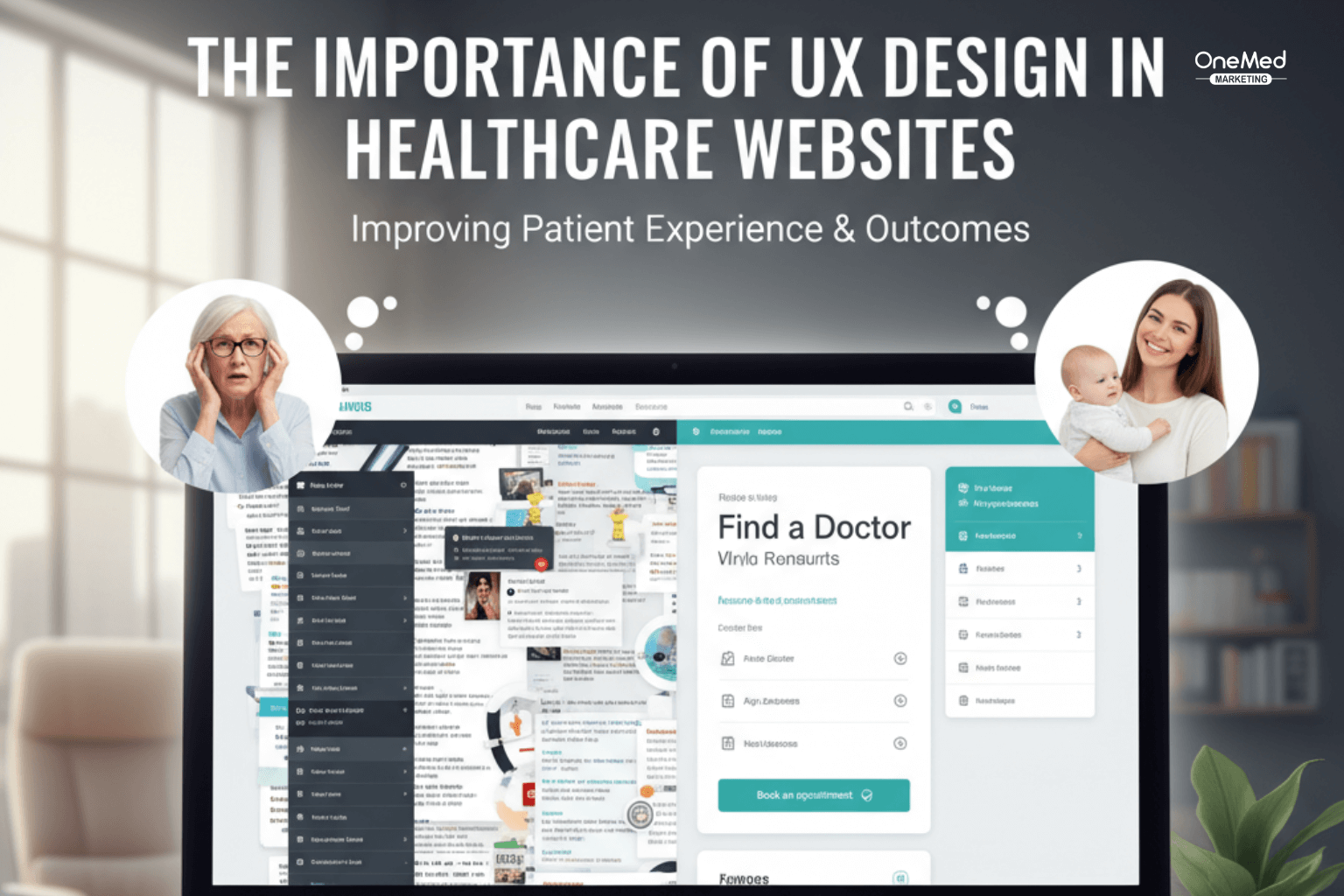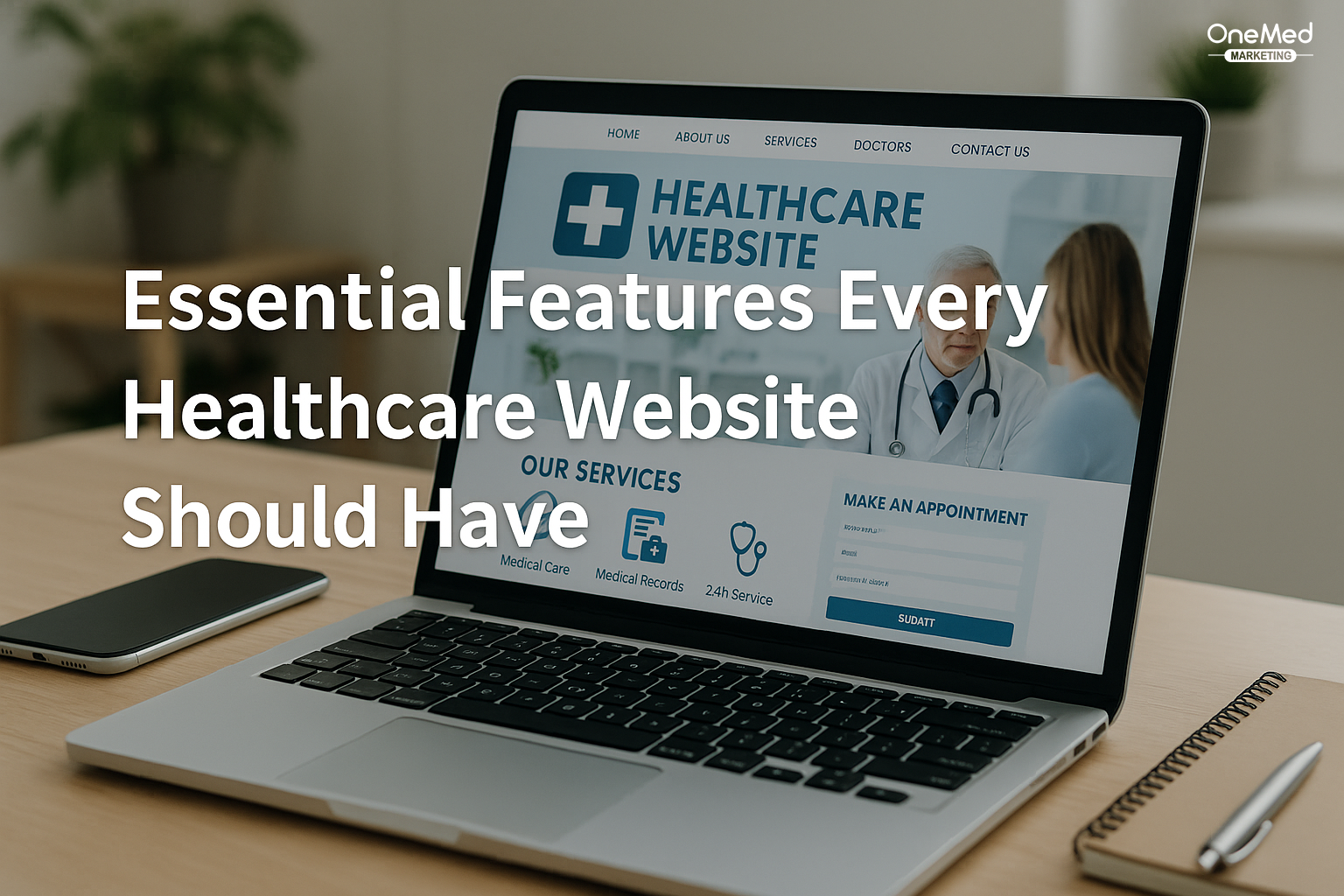- info@onemedmarketing.com
- 4th Floor, Nemours Building, 1007 North Orange St. , Wilmington, DE 19801, United States

The Importance of UX Design in Healthcare Websites
When patients look for care today, the first place they often go is a website. A healthcare website is no longer just an online brochure. It is where patients check services, read reviews, book appointments, and decide whether they can trust a provider. If the site is confusing or difficult to use, many patients will leave and look for another practice.
This is where user experience, or UX design, becomes critical. UX design focuses on how people interact with a website. A well-designed healthcare site helps patients find what they need quickly, builds trust, and creates a smooth experience from start to finish. For doctors, clinics, and hospitals, good UX can be the difference between gaining a new patient or losing one to a competitor.
In this blog, we will cover the following topics:
- What Is UX Design in Healthcare Websites?
- Why UX Design Matters for Healthcare Providers
- Key Elements of Good UX in Healthcare Websites
- How UX Design Impacts Patient Engagement
- Common UX Mistakes Healthcare Websites Make
- Best Practices for Improving UX in Healthcare Websites
- The Future of UX in Healthcare Websites
- Conclusion
- Frequently Asked Questions
What Is UX Design in Healthcare Websites?
Defining UX in simple terms
UX design is about making a website easy, clear, and pleasant to use. In healthcare, this means patients should be able to find information without frustration, schedule appointments with ease, and trust that the website is safe and reliable.
How UX design shapes patient experience online
A website is often the first interaction a patient has with a healthcare provider. If the experience is smooth, the patient feels more confident about booking care. If it is difficult, trust is lost before a provider ever meets the patient.
Why UX Design Matters for Healthcare Providers
First impressions and building trust
Patients often judge a provider by the quality of their website. A clean and professional design builds confidence, while a cluttered or outdated site can raise doubts about care quality.
Making information easy to find
Patients visit healthcare websites for clear answers: What services are offered? What are the office hours? How do I book an appointment? Good UX design makes this information easy to locate in just a few clicks.
Improving appointment booking and patient communication
An online booking system that is simple to use saves time for both patients and staff. Adding contact forms, chat support, or secure messaging also improves communication and helps patients feel supported.
Key Elements of Good UX in Healthcare Websites
Simple navigation and clean layout
Patients should not have to hunt for information. A simple menu with clear sections, supported by a clean design, helps them move through the site without confusion.
Mobile-friendly design for on-the-go patients
Most patients search for providers on their phones. A mobile-friendly site that adapts to smaller screens ensures they can find services and book visits without trouble.
Fast loading speeds and performance
Patients will leave if a page takes too long to load. Speed is not just about convenience; it also affects Google rankings, making fast sites easier to find.
Accessibility for patients with disabilities
Healthcare websites should follow accessibility standards. Features like screen reader support, alt text for images, and good color contrast help all patients use the site with ease.
How UX Design Impacts Patient Engagement
Encouraging patients to explore services
When a site is easy to navigate, patients are more likely to explore services, read blogs, or sign up for newsletters.
Supporting education through clear content and visuals
UX design also improves education. Using simple text, clear headings, and visuals like icons or infographics helps patients better understand their care.
Reducing frustration and bounce rates
If a site is confusing, patients will leave quickly, which increases bounce rates. A positive UX keeps patients engaged, increasing the chance they will schedule care.
Common UX Mistakes Healthcare Websites Make
Overloaded pages with too much text
Patients do not want to read long paragraphs filled with medical terms. Pages should focus on the essentials, written in plain language.
Complicated forms and booking processes
If a form takes too long to fill out, or if booking an appointment feels like a chore, patients may give up. Simple forms with only necessary fields work best.
Outdated design that looks untrustworthy
A website that looks old or neglected can make patients question the quality of care. Updating design regularly signals that the practice is modern and reliable.
Best Practices for Improving UX in Healthcare Websites
Designing with patients in mind
Think about what patients want when they visit the site. Clear service pages, easy booking options, and visible contact details should be priorities.
Testing usability with real users
Ask patients or staff to test the site and give feedback. Watching how real users navigate can reveal problems that may not be obvious to designers.
Using clear calls-to-action (CTAs)
Buttons like “Book Appointment” or “Call Now” should stand out and guide patients to the next step. CTAs should be simple and placed where patients expect them.
Keeping content simple and patient-focused
Content should always be written for patients, not for other clinicians. Using everyday language builds connection and prevents confusion.
The Future of UX in Healthcare Websites
Personalization and patient portals
Patients increasingly expect websites to feel personalized. Patient portals that provide test results, reminders, and tailored health information are becoming standard.
Integration with telehealth and online payments
As telehealth grows, websites will need seamless integration with video visits and secure online payments. These tools must be simple and user-friendly to succeed.
AI-driven tools to improve navigation and support
AI chatbots and virtual assistants can guide patients through a website, answer questions, and even help book appointments. When designed well, these tools improve the overall experience.
Conclusion
UX design is no longer a bonus feature for healthcare websites. It is essential for attracting patients, building trust, and improving the overall care experience. A website with poor design can push patients away before they ever step into the clinic, while a site with strong UX can make patients feel welcome, informed, and confident in their choice of provider.
By focusing on clear navigation, mobile access, fast performance, and patient-friendly content, providers can create websites that serve as reliable digital front doors. In the years ahead, investing in UX design will not only improve patient satisfaction but also strengthen the reputation and success of healthcare practices.
Frequently Asked Questions
1. What does UX design mean for healthcare websites?
UX design, or user experience design, is about making a website simple, clear, and easy to use. For healthcare websites, it ensures patients can quickly find services, book appointments, and trust the provider.
2. Why is UX important for doctors and clinics?
A good UX creates a positive first impression. Patients often judge a provider by their website. If the site is professional and easy to use, patients are more likely to trust the practice and book a visit.
3. What are the key elements of good UX in healthcare websites?
Important elements include simple navigation, mobile-friendly design, fast loading speeds, and accessibility for people with disabilities. These features make websites easier for all patients to use.
4. What are common mistakes in healthcare website design?
Some common mistakes are overloaded pages with too much text, complicated booking forms, and outdated designs. These issues frustrate patients and may drive them to another provider.







0 Comments
Leave a Comment